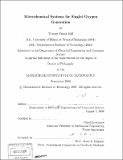Microchemical systems for singlet oxygen generation
Author(s)
Hill, Tyrone F. (Tyrone Frank), 1980-
DownloadFull printable version (35.46Mb)
Other Contributors
Massachusetts Institute of Technology. Dept. of Electrical Engineering and Computer Science.
Advisor
Carol Livermore.
Terms of use
Metadata
Show full item recordAbstract
Chemical Oxygen-Iodine Lasers (COIL) are a technology of interest for industrial and military audiences. COILs are flowing gas lasers where the gain medium of iodine atoms is collisionally pumped by singlet delta oxygen molecules, which are created through the catalyzed multiphase reaction of hydrogen peroxide and chlorine. Currently the use of COIL technology is limited by size and efficiency issues. This thesis seeks to use MEMS technology towards the development of more compact and efficient COIL systems, with a focus on the singlet oxygen generator (SOG) stage. Based on success in other applications, MEMS technology offers opportunities for improved reactant mixing, product separation, and heat transfer in SOGs. A MEMS singlet oxygen generator (or microSOG) is built and demonstrated. The chip features 32 multiplexed packed bed reaction channels and utilizes capillarity effects to separate the gas and liquid products. Cooling channels are arranged on the chip such that they form a cross-flow heat exchanger with the reaction channels. Spontaneous optical emission measurements and mass spectroscopy are used to confirm singlet oxygen production in the chip. A singlet delta oxygen molar flow rate corresponding to a power of 1.37 W was measured in the chip. The singlet oxygen molar flow rate per unit of hardware volume is 6.7x10-2 mol/L/sec, which represents an order of magnitude improvement over sparger and rotary SOG designs. A detailed physical model is developed to understand the behavior of the microSOG. This model is used along with the experimental results to gain insights into the poorly characterized singlet oxygen deactivation coefficients. Clogging and nonlinear hydraulic behavior prevented the first-generation microSOG from performing as well as the models originally suggested. These issues are addressed in a proposed second generation design, which simulations indicate will produce 50% more singlet oxygen per unit of hardware volume than its predecessor.
Description
Thesis (Ph. D.)--Massachusetts Institute of Technology, Dept. of Electrical Engineering and Computer Science, 2008. Includes bibliographical references (p. 153-158).
Date issued
2008Department
Massachusetts Institute of Technology. Department of Electrical Engineering and Computer SciencePublisher
Massachusetts Institute of Technology
Keywords
Electrical Engineering and Computer Science.